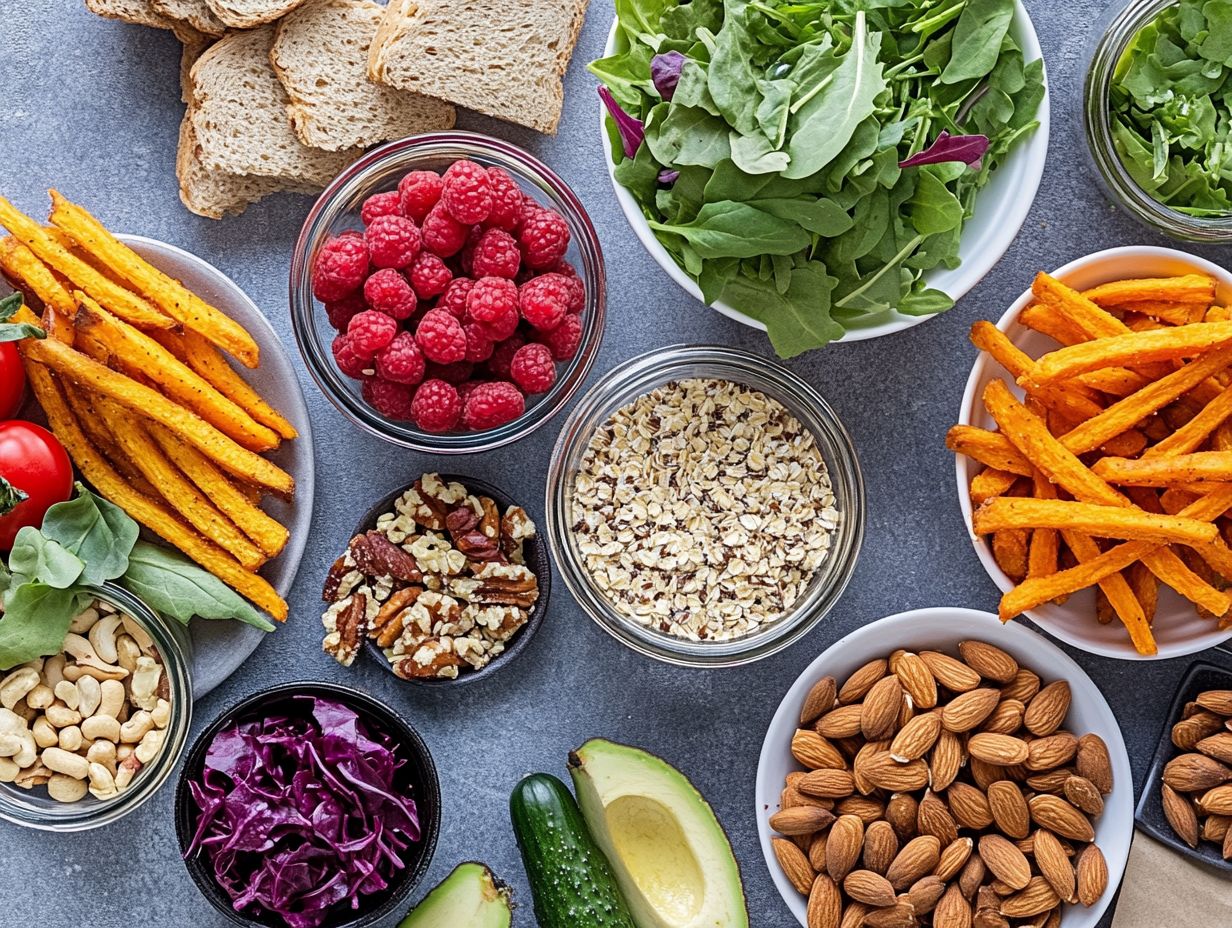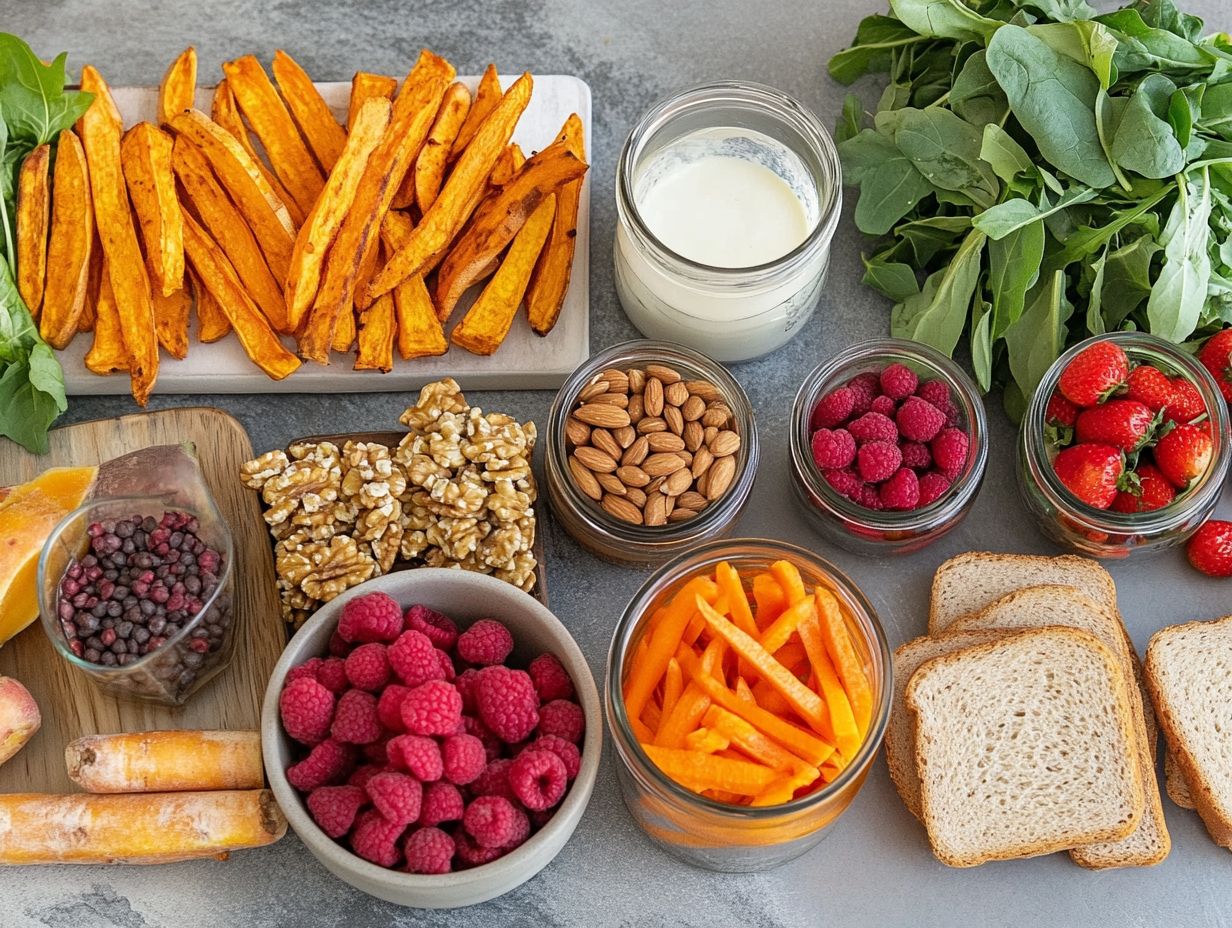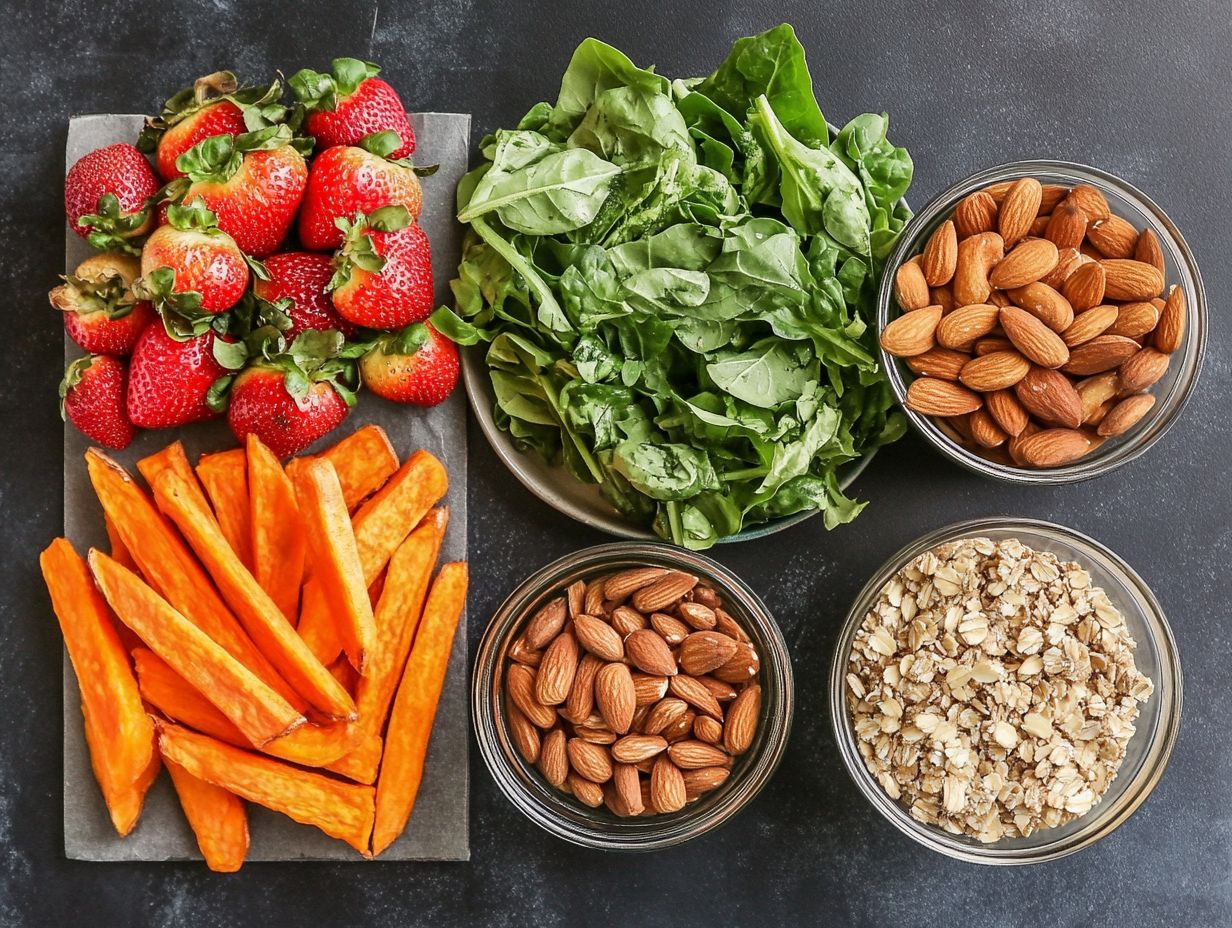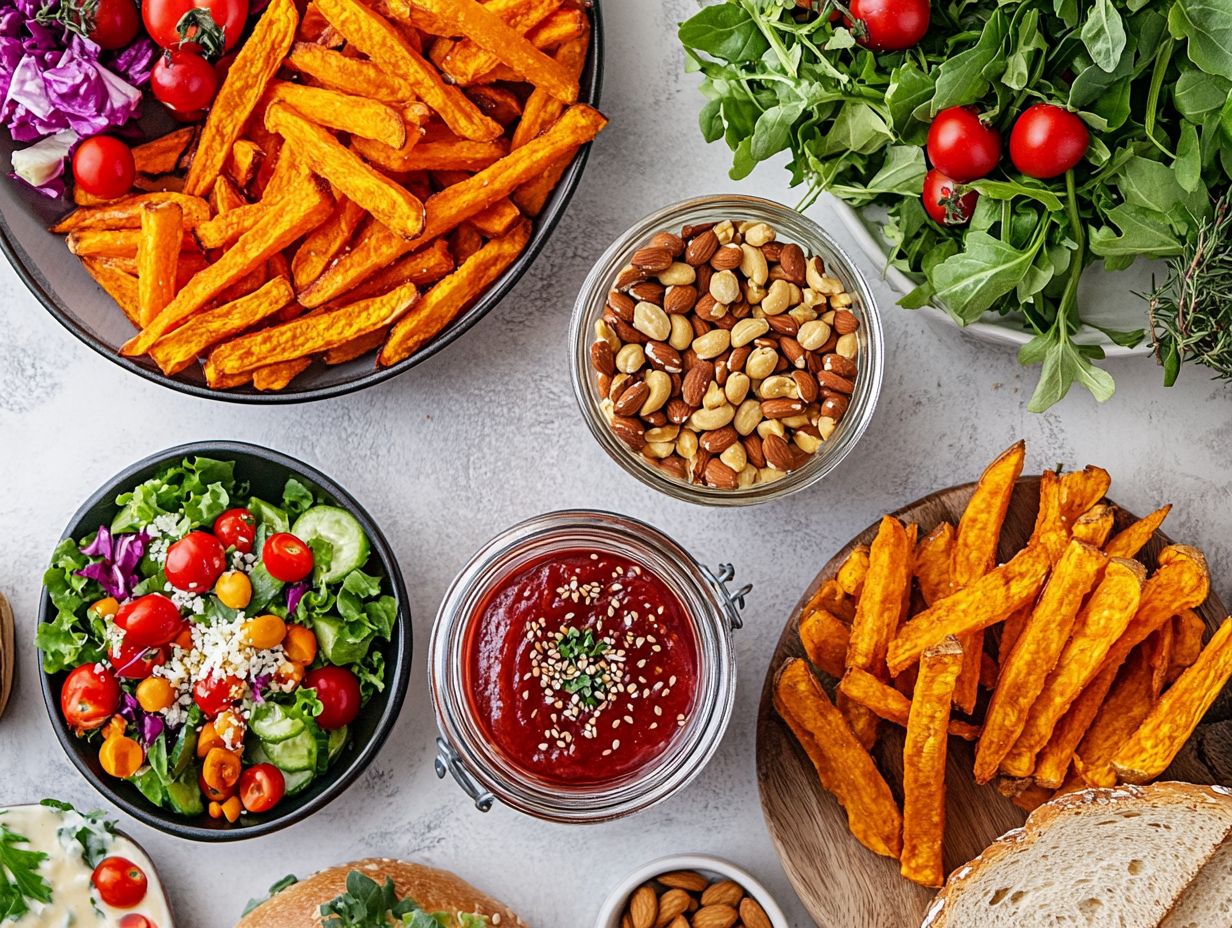How to Make Healthy Food Swaps?
In a world overflowing with food choices, making healthier choices can feel overwhelming, but it doesn t have to be! What if you could unlock significant improvements in your nutrition and overall well-being with just a few small, simple swaps?
This article delves into the concept of healthy food swaps replacing less nutritious options with nourishing alternatives. You ll explore the benefits and practical strategies for adding these changes to your meals.
Discover just how easy it can be to savor delicious meals while enhancing your health. Dive in and uncover how these simple adjustments can set the stage for lasting, positive habits!
Contents
Key Takeaways:

Choose nutrient-dense foods over processed and high-calorie options to improve your health and nutrition. Make small changes to your diet by swapping unhealthy foods for healthier alternatives to see long-term benefits. Incorporate healthy food swaps into your meal planning and use practical strategies to maintain a balanced and nutritious diet.
Understanding Healthy Food Swaps
Understanding healthy food swaps is crucial for enhancing your daily meals and fostering a healthier lifestyle. These swaps are simple substitutions that enable you to elevate your nutrition while still savoring the foods you adore.
By making informed choices like choosing whole grains over refined ones, such as white bread or white rice, or adding more dark greens like spinach, arugula, and kale you can significantly benefit your health.
Additionally, understanding these swaps helps improve portion control, reduce sugar intake, and refine your overall dietary patterns. These aspects are essential for promoting health awareness and effective weight management.
What Are Healthy Food Swaps?
Healthy food swaps involve the thoughtful practice of replacing less nutritious ingredients with healthier alternatives, enhancing your overall nutrition and well-being.
This concept is easy to incorporate into your daily cooking and meal prep, allowing you to savor your favorite dishes while boosting their nutritional value.
For example, swapping refined sugar with natural alternatives like honey or stevia can significantly lower your calorie intake without sacrificing sweetness.
Opting for low-fat dairy products instead of full-fat options is a smart strategy to reduce saturated fats while still enjoying the rich flavors of your meals.
Integrating whole grains instead of white flour not only enhances the fiber content but also elevates the nutritional profile of your baked goods.
By exploring these simple yet effective substitutions, you can transform your culinary habits and embrace a healthier lifestyle with ease.
Benefits of Making Healthy Food Swaps
Incorporating healthy food swaps into your diet can unlock a wealth of benefits, elevating not just your nutrition but your overall health as well. You might experience enhanced fiber intake, improved blood pressure regulation, and more favorable cholesterol levels.
Adopting cooking techniques that prioritize low salt and minimize sugar can drastically refine your dietary habits for the better. Moreover, these swaps are often wallet-friendly, enabling you to plan budget-conscious meals while promoting a balanced diet filled with nutrient-dense foods.
Improved Nutrition and Health

Improved nutrition and health are among the most significant benefits of making healthy food swaps, as they pave the way for a more balanced diet.
By replacing refined grains like white bread or white rice with whole grains, you can significantly boost your intake of dietary fiber and essential nutrients both of which are vital for digestive health and overall wellness.
These intentional dietary choices not only support weight management but also encourage mindful eating practices, fostering greater awareness of your food selections.
Choosing healthier alternatives, such as swapping sugary snacks for nutrient-dense fruits and nuts, fuels your body with the vitamins and minerals necessary for sustained energy and vitality.
Ultimately, these wellness strategies ensure that each meal becomes a step toward better health, cultivating a more nourishing lifestyle.
Ready to make your first swap? Let s get started!
Common Unhealthy Food Choices and Their Healthy Alternatives
Recognizing common unhealthy food choices and their healthier alternatives is essential for cultivating better eating habits and embracing a more vibrant lifestyle.
Many people often find themselves reaching for foods loaded with processed grains, sugars, and unhealthy fats. These choices can pave the way for health issues like diabetes and heart disease.
Make informed swaps! For example, choose steel-cut oats instead of instant oatmeal. Opt for popcorn chips over traditional potato chips. You can elevate your nutrition without sacrificing enjoyment.
Incorporate fresh fruits and vegetables into your diet. They supply vital nutrients while helping to lower your calorie intake.
Examples and Tips for Swapping Out Unhealthy Foods
Examples and tips for swapping out unhealthy foods can be invaluable in helping you make positive dietary changes. By choosing wholesome alternatives, you can significantly elevate your nutrient intake while still indulging in delicious meals.
For instance, if you swap white rice for quinoa, you not only boost your fiber intake but also enrich your plate with an array of vitamins and minerals. Regarding dairy, opt for low-fat options to achieve noticeable benefits without compromising flavor.
Consider using Greek yogurt instead of sour cream in your dips and dressings. It s a protein-packed, lower-calorie choice that can elevate your dishes. For late-night cravings, reach for healthy snacks like air-popped popcorn or fresh fruit slices they satisfy hunger and support overall wellness.
These simple adjustments can set you on the path to a healthier lifestyle!
How to Incorporate Healthy Food Swaps into Your Diet
Incorporating healthy food swaps into your diet demands careful meal planning and effective cooking techniques. Thoughtfully planning your daily meals helps pinpoint opportunities for simple substitutions that elevate your nutrition without compromising flavor.
For example, replace sugar with applesauce in your baking. This swap not only adds natural sweetness but also reduces added sugars. Choosing low-salt alternatives can markedly enhance your eating habits.
Get familiar with nutrition labels. This enables you to make informed decisions during grocery shopping, ensuring you select foods that align seamlessly with your health objectives.
Practical Strategies and Meal Planning

Practical strategies for meal planning can significantly simplify your journey toward incorporating healthy food swaps into your diet. By organizing your meals, you’ll minimize food waste and make grocery shopping more efficient.
Begin by examining your weekly schedule and carve out dedicated time for meal preparation. Engage in batch cooking by preparing larger portions of grains, proteins, and vegetables. You can then mix and match throughout the week, making your meals both varied and convenient.
If you’re seeking an even simpler approach, meal kit services might be your perfect solution. These services provide pre-portioned ingredients that encourage the use of healthy fats and sugar alternatives, taking the guesswork out of cooking.
Consider making gradual dietary changes, such as transitioning to whole foods or experimenting with new recipes that align with your health goals. Your culinary journey can be enjoyable and rewarding!
Staying Motivated and Maintaining Healthy Food Swaps
Staying motivated and making smart food swaps is crucial for achieving lasting success in your journey to a healthier lifestyle. Sustaining dietary changes can be challenging, especially when cravings for tempting unhealthy foods or social pressures arise.
Set realistic goals and celebrate small victories along the way. This will strengthen your commitment to making healthier choices.
Leverage resources like meal prep strategies, nutritious recipes, and wellness tips to keep you on track and maintain motivation throughout this rewarding journey. Start making these changes today and enjoy the vibrant, healthy life you deserve!
Tips for Long-Term Success
Transform your meals today! Achieving long-term success with healthy food swaps can seamlessly integrate into your lifestyle. By prioritizing foods that are healthy and filling, you can nourish your body while enjoying a variety of flavors and textures.
Incorporating meal planning into your weekly routine promotes a thoughtful approach to eating. This makes it easier to avoid impulsive choices that may not serve your health goals. Emphasizing mindful eating practices can turn your dining experience into something truly enjoyable, fostering a deeper appreciation for your meals and their impact on your overall well-being.
Set achievable goals and experiment with new recipes to keep your journey engaging. This makes it simpler to maintain positive habits over the long haul. Start making these swaps now to boost your health!
Frequently Asked Questions
What are some easy food swaps to make my meals healthier?

Some easy food swaps to make your meals healthier include using Greek yogurt instead of sour cream, swapping white rice for quinoa, and using avocado as a spread instead of mayonnaise.
How can I make my desserts healthier?
Make your desserts healthier by using applesauce or mashed bananas instead of oil or butter. Opt for dark chocolate instead of milk chocolate, and choose natural sweeteners like honey or maple syrup instead of sugar.
What are some ways to make my snacks healthier?
Choose fresh fruits and vegetables instead of processed snacks. Opt for air-popped popcorn instead of chips, and use hummus or guacamole as a dip instead of ranch or cheese dip.
How can I switch out unhealthy drinks for healthier options?
Switch out unhealthy drinks for healthier options by choosing water over sugary drinks. Opt for unsweetened tea or coffee instead of sweetened versions, and make your own smoothies with fresh fruits and vegetables instead of buying pre-made ones.
Are there any healthy food swaps for breakfast foods?
Yes! Use whole wheat toast instead of white toast, make overnight oats instead of sugary cereals, and use egg whites instead of whole eggs.
How can I make my lunches more nutritious?
Make your lunches more nutritious by using whole grain bread instead of white bread, adding veggies to your sandwiches and wraps, and choosing lean protein sources like grilled chicken or tofu instead of deli meats. Pack homemade salads instead of buying lunches from fast food restaurants.
Try these simple swaps today and taste the difference!






